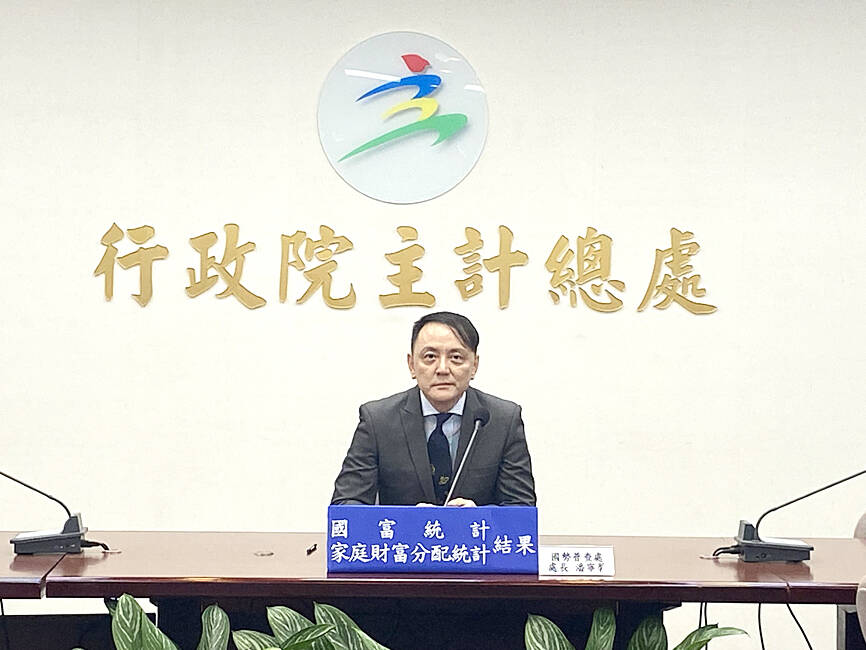Taiwan’s average wealth per household was NT$16.38 million (US$503,102) at the end of 2021, with about 71 percent of households coming in below the average, the Directorate-General of Budget, Accounting and Statistics (DGBAS) said yesterday.
Median wealth per household was NT$8.94 million, said the agency, which released the data for the first time in 30 years.
The Gini coefficient for Taiwanese households — a measure of inequality where zero indicates complete equality of wealth and one indicates complete inequality — was 0.606 at the end of 2021, lower than Australia’s 0.611, the UK’s 0.620, Japan’s 0.678, France’s 0.676 and Germany’s 0.727, the agency said in a report.

Photo: Clare Cheng, Taipei Times
The average wealth among the top 20 percent of Taiwanese households was NT$51.33 million in 2021, accounting for 62.68 percent of total household wealth, while the average for the bottom 20 percent was NT$770,000, or 0.94 percent of the total, the data showed.
As a result, the average household wealth for the top 20 percent was 66.9 times higher than for the bottom 20 percent, lower than Australia’s 93.1 times, the UK’s 109.5, South Korea’s 140.1 and France’s 627.4, meaning that household wealth distribution is relatively even in Taiwan, the DGBAS said.
The last time the DGBAS released a wealth distribution report was in 1992. The agency has not released a similar report since then because data was difficult to come by due to the need for personal information, it said.
Unlike the previous report, which was based on a survey of households the previous year, the latest report was compiled using surveys of family income and expenditure, along with other household data such as assets and liabilities, the agency said, urging caution when making comparisons as the two reports used different data collection and statistical methods.
In the previous report, the average household wealth was NT$5.26 million in 1991, with the top 20 percent’s wealth 16.8 times higher than that of the bottom 20 percent, while the Gini coefficient was 0.47 at that time, DGBAS data showed.
The widening gap in wealth disparity is inevitable in free economies, but Taiwan's wealth inequality is less severe than in many other countries, DGBAS Census Department Director Pan Ning-hsin (潘寧馨) said at a news conference yesterday.
The agency yesterday also reported that Taiwan’s gross national wealth was NT$310.61 trillion at the end of 2022, an increase of NT$26.18 trillion, or 9.2 percent, from the end of 2021, while net national wealth was NT$247.14 trillion, also an increase of NT$21.72 trillion, or 9.63 percent, from a year earlier.
National wealth statistics represent the current value of all goods owned by the people in a nation at the end of year, the agency said.
Gross national wealth is the total value of net assets on current prices owned by five sectors: households, non-profit institutions, non-financial enterprises, financial enterprises and government, and net national wealth represents the assets value of gross national wealth with depreciation being deducted, it said.
At the end of 2022, the net worth — assets minus liabilities — of the household sector was NT$159.08 trillion, accounting for 64.37 percent of the net worth of all sectors, the report showed.
Additional reporting by CNA

People can preregister to receive their NT$10,000 (US$325) cash distributed from the central government on Nov. 5 after President William Lai (賴清德) yesterday signed the Special Budget for Strengthening Economic, Social and National Security Resilience, the Executive Yuan told a news conference last night. The special budget, passed by the Legislative Yuan on Friday last week with a cash handout budget of NT$236 billion, was officially submitted to the Executive Yuan and the Presidential Office yesterday afternoon. People can register through the official Web site at https://10000.gov.tw to have the funds deposited into their bank accounts, withdraw the funds at automated teller

PEACE AND STABILITY: Maintaining the cross-strait ‘status quo’ has long been the government’s position, the Ministry of Foreign Affairs said Taiwan is committed to maintaining the cross-strait “status quo” and seeks no escalation of tensions, the Ministry of Foreign Affairs (MOFA) said yesterday, rebutting a Time magazine opinion piece that described President William Lai (賴清德) as a “reckless leader.” The article, titled “The US Must Beware of Taiwan’s Reckless Leader,” was written by Lyle Goldstein, director of the Asia Program at the Washington-based Defense Priorities think tank. Goldstein wrote that Taiwan is “the world’s most dangerous flashpoint” amid ongoing conflicts in the Middle East and Russia’s invasion of Ukraine. He said that the situation in the Taiwan Strait has become less stable

CONCESSION: A Shin Kong official said that the firm was ‘willing to contribute’ to the nation, as the move would enable Nvidia Crop to build its headquarters in Taiwan Shin Kong Life Insurance Co (新光人壽) yesterday said it would relinquish land-use rights, or known as surface rights, for two plots in Taipei’s Beitou District (北投), paving the way for Nvidia Corp to expand its office footprint in Taiwan. The insurer said it made the decision “in the interest of the nation’s greater good” and would not seek compensation from taxpayers for potential future losses, calling the move a gesture to resolve a months-long impasse among the insurer, the Taipei City Government and the US chip giant. “The decision was made on the condition that the Taipei City Government reimburses the related

FRESH LOOK: A committee would gather expert and public input on the themes and visual motifs that would appear on the notes, the central bank governor said The central bank has launched a comprehensive redesign of New Taiwan dollar banknotes to enhance anti-counterfeiting measures, improve accessibility and align the bills with global sustainability standards, Governor Yang Chin-long (楊金龍) told a meeting of the legislature’s Finance Committee yesterday. The overhaul would affect all five denominations — NT$100, NT$200, NT$500, NT$1,000 and NT$2,000 notes — but not coins, Yang said. It would be the first major update to the banknotes in 24 years, as the current series, introduced in 2001, has remained in circulation amid rapid advances in printing technology and security standards. “Updating the notes is essential to safeguard the integrity